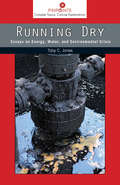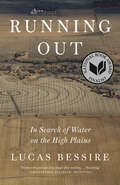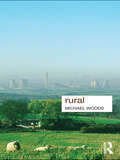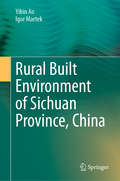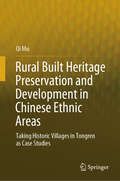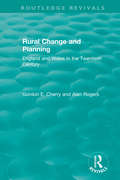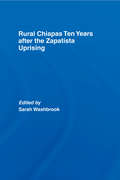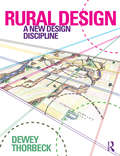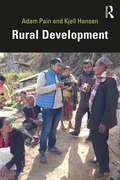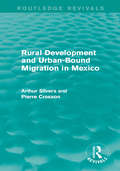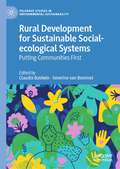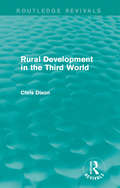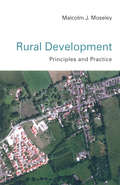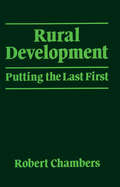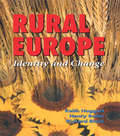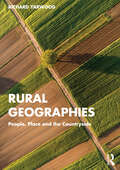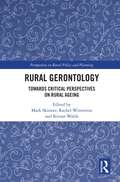- Table View
- List View
Running Dry
by Toby Craig JonesThe world's water is under siege. A combination of corporate greed, the elite pursuit of political power, and our unrelenting reliance on carbon-based energy is accerlating a broad range of environmental and political crises. Potentially catastrophic climate change, driven primarily by the consumption of oil and gas, threatens the environment in a variety of ways, including producing unprecedented patterns of heavy weather and superstorms in some places and droughts in others. Alongside intensifying environmental dangers posed by our reliance on carbon energy, the conditions of modern life, from happiness to the possibility of democratic politics, are also being undermined. In Running Dry, historian Toby Craig Jones explores how modern society's unquenchable thirst for carbon-based energy is endangering the environment broadly, as well as the historical roots of this threat. This accessible book examines the history of the "energy-water nexus," the ways in which oil and gas extraction poison and dry up water resources, the role of corporate "science" in deflecting attention away from the emerging crises, and the ways in which the rush to capture more energy is also challenging America's democratic order.
Running Out: In Search of Water on the High Plains
by Lucas BessireFinalist for the National Book AwardAn intimate reckoning with aquifer depletion in America's heartlandThe Ogallala aquifer has nourished life on the American Great Plains for millennia. But less than a century of unsustainable irrigation farming has taxed much of the aquifer beyond repair. The imminent depletion of the Ogallala and other aquifers around the world is a defining planetary crisis of our times. Running Out offers a uniquely personal account of aquifer depletion and the deeper layers through which it gains meaning and force.Anthropologist Lucas Bessire journeyed back to western Kansas, where five generations of his family lived as irrigation farmers and ranchers, to try to make sense of this vital resource and its loss. His search for water across the drying High Plains brings the reader face to face with the stark realities of industrial agriculture, eroding democratic norms, and surreal interpretations of a looming disaster. Yet the destination is far from predictable, as the book seeks to move beyond the words and genres through which destruction is often known. Instead, this journey into the morass of eradication offers a series of unexpected discoveries about what it means to inherit the troubled legacies of the past and how we can take responsibility for a more inclusive, sustainable future.An urgent and unsettling meditation on environmental change, Running Out is a revelatory account of family, complicity, loss, and what it means to find your way back home.
Running on Sunshine: How Does Solar Energy Work? (Let's-Read-and-Find-Out Science 2)
by Carolyn Cinami DeCristofanoRead and find out about solar energy in this colorfully illustrated nonfiction picture book.The sun is a source of energy for living things. Energy that comes from sunshine is called solar energy. But how does solar energy work? And how can we use solar energy to not only stay on the cutting-edge of technology, but to help keep the environment healthy? Read and find out about solar roads that light up when there’s danger ahead, like a moose on the road—and did you know that someday tiny solar chips placed in someone’s eyes could help a blind person see? Learn all this and more!Running on Sunshine comes packed with visual aids like charts, sidebars, an infographic, and a hands-on activity—how to direct sunlight using mirrors! Both the text and the artwork were vetted for accuracy by Dr. Bart Bartlett, Associate Professor of Chemistry at the University of Michigan.This is a clear and appealing science book for early elementary age kids, both at home and in the classroom. It's a Level 2 Let's-Read-and-Find-Out, which means the book explores more challenging concepts for children in the primary grades. The 100+ titles in this leading nonfiction series are:hands-on and visualacclaimed and trustedgreat for classroomsTop 10 reasons to love LRFOs:Entertain and educate at the same timeHave appealing, child-centered topicsDevelopmentally appropriate for emerging readersFocused; answering questions instead of using survey approachEmploy engaging picture book quality illustrationsUse simple charts and graphics to improve visual literacy skillsFeature hands-on activities to engage young scientistsMeet national science education standardsWritten/illustrated by award-winning authors/illustrators & vetted by an expert in the fieldOver 130 titles in print, meeting a wide range of kids' scientific interestsBooks in this series support the Common Core Learning Standards, Next Generation Science Standards, and the Science, Technology, Engineering, and Math (STEM) standards. Let's-Read-and-Find-Out is the winner of the American Association for the Advancement of Science/Subaru Science Books & Films Prize for Outstanding Science Series.
Runoff Prediction in Ungauged Basins
by Hubert Savenije Günter Blöschl Murugesu Sivapalan Thorsten Wagener Alberto ViglionePredicting water runoff in ungauged water catchment areas is vital to practical applications such as the design of drainage infrastructure and flooding defences, runoff forecasting, and for catchment management tasks such as water allocation and climate impact analysis. This full colour book offers an impressive synthesis of decades of international research, forming a holistic approach to catchment hydrology and providing a one-stop resource for hydrologists in both developed and developing countries. Topics include data for runoff regionalisation, the prediction of runoff hydrographs, flow duration curves, flow paths and residence times, annual and seasonal runoff, and floods. Illustrated with many case studies and including a final chapter on recommendations for researchers and practitioners, this book is written by expert authors involved in the prestigious IAHS PUB initiative. It is a key resource for academic researchers and professionals in the fields of hydrology, hydrogeology, ecology, geography, soil science, and environmental and civil engineering.
Rural
by Michael WoodsThe division of ‘rural’ and ‘urban’ is one of the oldest ideas in Geography and is deeply engrained in our culture. Throughout history, the rural has been attributed with many meanings: as a source of food and energy; as a pristine wilderness, or as a bucolic idyll; as a playground, or a place of escape; as a fragile space of nature, in need of protection; and as a primitive place, in need of modernization. But is the idea of the rural still relevant today? Rural provides an advanced introduction to the study of rural places and processes in Geography and related disciplines. Drawing extensively on the latest research in rural geography, this book explores the diverse meanings that have been attached to the rural, examines how ideas of the rural have been produced and reproduced, and investigates the influence of different ideas in shaping the social and economic structure of rural localities and the everyday lives of people who live, work or play in rural areas. This authoritative book contains case studies drawn from both the developed and developing world to introduce and illustrate conceptual ideas and approaches, as well as suggested further reading. Written in an engaging and lively style, Rural challenges the reader to think differently about the rural.
Rural Built Environment of Sichuan Province, China
by Yibin Ao Igor MartekMajor changes are taking place in the Chinese countryside as China rushes to modernizes and urbanizes its rural fabric. The transformation is improving the quality of life of rural inhabitants, but also brings about challenges as people strive to adjust. This book systematically examines the impact of change on the daily lives and activities of the residents of Sichuan Province, in China’s South-west. It examines the themes of infrastructure, transport modes and preferences, sanitation, water conservation, earthquake and flood disaster preparedness, and the impact these have on villager behavior and quality of life. This book is an essential reference guide for graduate students and practitioners in the fields of rural planning, renewal, and construction.
Rural Built Heritage Preservation and Development in Chinese Ethnic Areas: Taking Historic Villages in Tongren as Case Studies
by Qi MuThis book discusses how rural built heritage preservation and development in the Chinese ethnic area in Tongren, China has been strongly addressed by the labeling, planning, project-making, follow-up management characterized by different patterns of stakeholders. Moreover, the rural built heritage preservation and development is an instrument of power that has been incorporated into the municipal, county and lower-level planning settings, portraying an overall top-down government-led feature. An intentional laddered development for the government’s overall strategy of resource allocation and spatial reorganization has been identified. Different patterns of stakeholders are identified. This book discusses how different roles played by stakeholders tend to be inseparable and often overlapped thus forming ambiguous and difficulty controllable dynamics in shaping the rural built environment. In conclusion, insights have been provided based on the debates of AHD and positioning rural built heritage preservation within the public governance.
Rural Change and Planning: England and Wales in the Twentieth Century (Routledge Revivals)
by Alan Rogers Gordon E. CherryOriginally published in 1996 Rural Change and Planning describes the turbulent changes that have occurred in rural England and Wales since the outbreak of the First World War. The book describes the changes from an agriculturally-dominated countryside to one which has had to increasingly adapt to urban pressures. Looking at the changes chronologically, the book provides an integrated history of rural planning in the twentieth century and the developments which have taken place within the State, which has facilitated those changes. The book looks at the social and economic impacts of two world wars on agricultural communities, and the pressures of industry, new settlements and the effects of recreation on rural landscapes.
Rural Change in Australia: Population, Economy, Environment (Perspectives On Rural Policy And Planning Ser.)
by John ConnellNew twenty-first century economic, social and environmental changes have challenged and reshaped rural Australia. They range from ageing populations, youth out-migration, immigration policies (that seek to place skilled migrants in rural Australia), tree changers, agricultural restructuring and new relationships with indigenous populations. Challenges also exist around the 'patchwork economy' and the wealth that the mining boom offers some areas, while threatening regional economic decline in others. Rural Australia is increasingly not simply a place of production of agriculture and minerals but an idea that individuals seek and are encouraged to consume. The socio-economic implications of drought, water rights and changing farming practices, have prefaced new social, cultural and economic reforms. This book provides a contemporary perspective on rapidly evolving population, economic and environmental changes in 'rural and regional Australia', itself a significant concept. Bringing together a range of empirical studies, the book builds on established rural studies themes such as population change, economic restructuring and globalisation in agriculture but links such changes to environmental change, culture, class, gender, and ethnic diversity. Presenting original and in-depth interventions on these issues and their intersections, this book assembles the best of contemporary research on rural Australia.
Rural Chiapas Ten Years after the Zapatista Uprising
by Sarah WashbrookConsidered the most significant recent agrarian movement in Mexico, the 1994 EZLN uprising by the indigenous peasantry of Chiapas attracted world attention. Timed to coincide with the signing of the NAFTA agreement, the Zapatista Army of National Liberation reasserted the value of indigenous culture and opposed the spread of neo-liberalism associated with globalization. The essays in this collection examine the background to the 1994 uprising, together with the reasons for this, and also the developments in Chiapas and Mexico in the years since. Among the issues covered are the history of land reform in the region, the role of peasant and religious organizations in constructing a new politics of identity, the participation in the rebellion of indigenous women and changing gender relations, plus the impact of the Zapatistas on Mexican democracy. The international group of scholars contributing to the volume include Sarah Washbrook, George and Jane Collier, Antonio García de León, Daniel Villafuerte Solís, Gemma van der Haar, Mercedes Olivera, Marco Estrada Saavedra, Heidi Moksnes, Neil Harvey, and Tom Brass.This book was previously published as a special issue of The Journal of Peasant Studies.
Rural Design: A New Design Discipline
by Dewey ThorbeckRural areas worldwide are undergoing profound change creating considerable challenges and stress for its residents and on the ecosystems upon which they depend. Rural design brings design thinking and the problem-solving process of design to rural issues recognizing that human and natural systems are inextricably coupled and engaged in continuous cycles of mutual influence and response. This book is the first step along the path for rural design to emerge as an important new design discipline. Rural Design: A New Design Discipline establishes the theoretical base for rural design and the importance of looking at connecting issues to create synergy and optimal solutions from a global, national, state, region, and local perspective. To be effective and relevant, this new discipline must be founded on solid research, and practice must be based on data-driven evidence that will result in transformational changes. These directions and others will enable rural design to: help rural communities make land use, architectural, and aesthetic decisions that enhance their quality of life and the environment connect social, artistic, cultural, technological, and environmental issues that create rural place promote sustainable economic development for rural communities and improve human, livestock, crop, and ecosystem health and integrate research and practice across the many disciplines involved in rural issues to meet rural needs, provide new data, and provoke new research questions. Written by a world leading expert in rural design, who is director and founder of the University of Minnesota Center for Rural Design, the book is oriented toward students, academics and design professionals involved with rural design at any level.
Rural Development
by Adam Pain Kjell HansenRural Development is a textbook that critically examines economic, social and cultural aspects of rural development efforts both in the global north and in the global south. By consistently using examples from the north and the south the book highlights similarities of processes as well as differences in contexts. The authors’ knowledge of Afghanistan and Sweden respectively creates a core for the discussions which are complemented with a wide range of other empirical examples. Rural Development is divided into nine chapters, each with a thematic focus, ranging from concepts and theories through rural livelihoods and natural resources to discussions on policy and processes of change. The book sees rural development as a multi-level, multi-actor and multi-faceted subject area that needs multidisciplinary perspectives both to support it and to analyse it. Throughout the book examples of rural development interventions are discussed using analytical concepts such as power, discourse, consequences and context to grasp rural development as practices that are more than what is presented in policy documents. The book is written in a way that makes it accessible for undergraduates while at the same time caters for the kind of deeper reading used by master students and Ph.D.’s. Every chapter is linked to discussion questions as well as suggested further readings and useful websites.
Rural Development Theory and Practice (Routledge Studies in Development and Society)
by Ruth McAreaveyRural development is inherently viewed as a positive thing; it is seen as something that brings together groups of individuals with automatic positive implications and outcomes. Policy rhetoric frequently uses popular terms such as involvement, participation and power sharing to describe rural development activities. However, the reality of experience on the ground does not necessarily concur with these ideals. It is not always clear who ultimately benefits from rural development: the State, the community or rural development practitioners. This book critically analyses key concepts associated with rural development policy and practice, and using the concepts of power and micro-politics to analyze rhetoric and reality, reveals the intricacies of rural development. Challenging popular ideals associated with rural development, this book presents the notion of rural development less as a spontaneous, all-inclusive affair and more as a limited, controlled and exclusive process. Ultimately it contends that within structures of rural governance, a regeneration power elite predominates development and regeneration activities.
Rural Development and Urban-Bound Migration in Mexico (Routledge Revivals)
by Pierre Crosson Arthur SilversRapid growth of urban populations is a major characteristic of economic development and demographic change in developing countries leading to industrialisation and modernisation of major cities. Originally published in 1980, this study focusses on these issues using Mexico as a case study as well as analysing the risk of over-urbanisation and what the effects will be on cities such as Mexico City. This title will be of interest to students of Environmental studies and Economics.
Rural Development and the Construction of New Markets (Routledge ISS Studies in Rural Livelihoods)
by Jan Douwe van der Ploeg Paul Hebinck Sergio SchneiderThis book focuses on empirical experiences related to market development, and specifically new markets with structurally different characteristics than mainstream markets. Europe, Brazil, China and the rather robust and complex African experiences are covered to provide a rich multidisciplinary and multi-level analysis of the dynamics of newly emerging markets. Rural Development and the Construction of New Markets analyses newly constructed markets as nested markets. Although they are specific market segments that are nested in the wider commodity markets for food, they have a different nature, different dynamics, a different redistribution of value added, different prices and different relations between producers and consumers. Nested markets embody distinction viz-a-viz the general markets in which they are embedded. A key aspect of nested markets is that these are constructed in and through social struggles, which in turn positions this book in relation to classic and new institutional economic analyses of markets. These markets emerge as steadily growing parts of the farmer populations are dedicating their time, energy and resources to the design and production of new goods and services that differ from conventional agricultural outputs. The speed and intensity with which this is taking place, and the products and services involved, vary considerably across the world. In large parts of the South, notably Africa, farmers are ‘structurally’ combining farming with other activities. By contrast, in Europe and large parts of Latin America farmers have taken steps to generate new products and services which exist alongside ongoing agricultural production. This book not only discusses the economic rationales and dynamics for these markets, but also their likely futures and the threats and opportunities they face.
Rural Development for Sustainable Social-ecological Systems: Putting Communities First (Palgrave Studies in Environmental Sustainability)
by Séverine Van Bommel Claudia BaldwinThis book provides an overview of interdisciplinary approaches that have applied social science to research focused on issues around food, agriculture and natural resource management. The book demonstrates that those who work in rural sociology either as researchers or practitioners apply community development and participatory techniques to socio-environmental interaction. The book discusses how the evolving concept of interconnected social and ecological systems (SES) emerged, recognizing the inherent complexity, adaptive nature, and resilience of such systems. This book engages with contemporary theory, as well as new cutting-edge transdisciplinary research evidenced in case studies from three continents.
Rural Development in the Third World (Routledge Revivals)
by Chris DixonThe rural landscape of the Third World is generally seen as one worked by the impoverished. Chris Dixon shows that this is an increasingly inaccurate picture. Wealth does exist, with the landed often maintaining lifestyles comparable to their richest urban neighbours. And while land remains the basis of real wealth, the rural workforce is diversifying its activities away from agriculture becoming involved in a range of manufacturing, processing, trading and service industries. Yet still rural poverty persists, and the book illustrates just how difficult it is to assess the success of development initiatives adopted to eliminate it. This book, first published in 1990, provides a general introduction to the approaches, policies, and problems associated with Third World rural development. Rural Development in the Third World is relevant to students of geography, the environment and developmental issues.
Rural Development: Principles and Practice (Cabi Publishing Ser.)
by Professor Malcolm Moseley`Malcolm Moseley makes an impressive job of "cutting through the cackle" and has produced a definitive catch-all volume to inform students, practitioners, community activists and local decision makers alike.... The book is transparently and logically laid out.... From a personal perspective as community activist and local authority member, I found the book invaluable. Here were satisfying definitions of terms I have grappled with for years - "rural", "community", "sustainable", "social capital", "capacity building", "the leaky bucket". Here also were some outstanding examples of good practice... In sum, this is a rural community development painting by numbers in the hands of an old master, well worth around £20 of investment' - The Rural Digest Advocating the fundamental need for an innovative and holistic approach to rural development, Rural Development: Principles and Practice demonstrates and explains, whilst seeking to improve, the mechanisms for planning, managing and financing rural development at the local level. This book is structured in terms of the key concepts of this field: sustainability, innovation, adding value, entrepreneurship, community, social inclusion, accessibility, partnership, community involvement, diagnosis, strategic planning, implementation and evaluation. Each is then placed into a practical context by two illustrative case studies related to development in rural Europe, the initiatives of which the author was either personally involved in or had personal knowledge. The first director of ACRE (the national voluntary organisation committed to promoting the vitality of England's villages and small towns and to improving the quality of life of their disadvantaged residents), Malcolm Moseley is a researcher, teacher and consultant in the European Union's `LEADER Rural Development Programme' and the Countryside and Community Research Unit of the University of Gloucestershire. The author draws from this wealth of personal experience with the aim of providing activists, practitioners and specialists, as well as students, a concise and operational text which links the theory and practice of undertaking locally focused rural development. As such, Rural Development: Principles and Practice is essential reading for all interested or actively involved in local rural development issues.
Rural Development: Putting the last first (World Development)
by Robert ChambersRural poverty is often unseen or misperceived by outsiders. Dr Chambers contends that researchers, scientists, administrators and fieldworkers rarely appreciate the richness and validity of rural people's knowledge or the hidden nature of rural poverty. This is a challenging book for all concerned with rural development, as practitioners, academics, students or researchers.
Rural Electrification: Strategies for Distributed Generation
by Hisham ZerriffiFor those in developed nations, suddenly being without electricity is a disaster: power cuts have us fretting over the food stored in the freezer, and even a few hours without lights, televisions, or air conditioning is an ordeal. However, for an estimated 1.6 billion people worldwide, the absence of electricity is their daily experience. An untold number of others live with electricity that is erratic and of poor quality. How can electric power be brought into their lives when the centralized utility models that have evolved in developed nations are not an economically viable option? Poor, rural communities in developing nations cannot simply be 'plugged in' to a grid. Small-scale Distributed Generation (DG), ranging from individual solar home systems to village level grids run off diesel generators, could provide the answer, and this book compares around 20 DG enterprises and projects in Brazil, Cambodia and China, each of which is considered to be a "business model" for distributed rural electrification. While large, centralized power projects often rely on big subsidies, this study shows that privately run and localized solutions can be both self-sustaining and replicable. Its three sections provide a general introduction to the issue of electrification and rural development, set out the details of the case studies and compare the models involved, and discuss the important thematic issues of equity, access to capital and cost-recovery. Hisham Zerriffi shows that in each case, it is not simply a matter of matching a particular technology to a particular need. Numerous institutional factors come into play including the regulatory regime, access to financial services, and government/utility support or opposition to the DG alternative. Despite this, in many countries, the question is not whether DG has a role to play. Rather it is a question of how it will play a role.
Rural Environmental Planning for Sustainable Communities
by Frederic O. Sargent Jose Rivera Paul Lusk Maria VarelaRural Environmental Planning for Sustainable Communities offers an explanation of the concept of Rural Environmental Planning (REP) along with case studies that show how to apply REP to specific issues such as preserving agricultural lands, planning river and lake basins, and preserving historical sites.
Rural Europe: Identity And Change (Perspectives On Rural Policy And Planning Ser.)
by Richard Black Keith Hoggart Henry BullerExamines the interaction of the economic, political and social change processes within Europe which are bringing about fundamental transformations in rural areas. The authors expand on this view of rural Europe, and place its significance within the broader field of rural studies.
Rural Geographies: People, Place and the Countryside
by Richard YarwoodRural Geographies provides a critical, contemporary and accessible introduction to rural change by using geographical ideas to understand current issues affecting the countryside. The book discusses how the countryside has been studied by geographers across a range of different scales, from village community to the global countryside. Each chapter provides a concise and well-illustrated introduction to a key theme in rural geography, using current literature and contemporary examples. The book is divided into four sections that cover rural contexts, changes, contests and cultures. The volume takes a global perspective but is largely centred on the Global North, reflecting the tradition of scholarship in rural geography. Rural Geographies is driven by thinking in human geography. It reflects how major paradigmatic changes in the discipline have impacted, and have been informed by, the sub-discipline of rural geography. The aim is to introduce key ideas and concepts that will teach students the critical skills necessary to analyse rural issues themselves. The text will be a valuable resource for undergraduate students studying rural geography and rural studies.
Rural Geography: Processes, Responses and Experiences in Rural Restructuring (Key Ideas In Geography Ser.)
by Michael Woods"Michael Woods has taken on the formidable task of giving an overview of rural places and society in advanced economies as a single author and has presented a book that rightly deserves to be called state-of-the-art." - Geographische Rundschau "With Rural Geography Michael Woods remedies the often underestimated dynamism of rural places and rural society by providing the much-needed synthesis of the European and North American literature on rural restructuring and globalization processes." - Patrick H Mooney, University of Kentucky Rural Geography is an introduction to contemporary rural societies and economies in the developed world. It examines the social and economic processes at work in the contemporary countryside - including the more traditional: like agriculture; land use; and population; as well as wider themes like: rural health, crime, exclusion, commodification; and alternative lifestyles. With a contextualising section defining the rural, the text is organised systematically in three principal sections: Processes of Rural Restructuring Responses to Rural Restructuring Experiences of Rural Restructuring Using the most recent empirical material , statistical data and research, the text is global in perspective using comparative examples throughout. Rural Geography is a systematic introduction to the processes, responses, and experiences of rural restructuring.
Rural Gerontology: Towards Critical Perspectives on Rural Ageing (Perspectives on Rural Policy and Planning)
by Kieran Walsh Mark Skinner Rachel WintertonThis book provides the first foundation of knowledge about the intellectual traditions, contemporary scope and future prospects for the interdisciplinary field of rural gerontology. With a focus on rural regions, small towns and villages, which have the highest rates of population ageing worldwide, Rural Gerontology is aimed at understanding what it means for rural people, communities and institutions to be at the forefront of twenty-first-century demographic change. The book offers important insights from rural ageing studies into today’s most pressing gerontological problems. With chapters from more than 65 established and emerging rural ageing researchers, it is the first synthesis of knowledge about rural gerontology, harnessing a burgeoning interdisciplinary scholarship on the rural dimensions of ageing, old age and older populations. With a view to advancing a critical understanding of rural ageing populations, this book will have an overreaching impact across the social sciences by drawing on advancements in understandings of rural ageing from social, environmental, geographical and critical gerontology to facilitate a comprehensive exploration of the diversity, complexity and implications of the ageing process in rural settings. Bringing together valuable international perspectives, this book makes a timely contribution to gerontology, rural studies and the social sciences, and will appeal to scholars and researchers across USA and Canada, UK and Ireland, Australia and New Zealand, Europe, China and countries in Africa, South America and South-East Asia.
